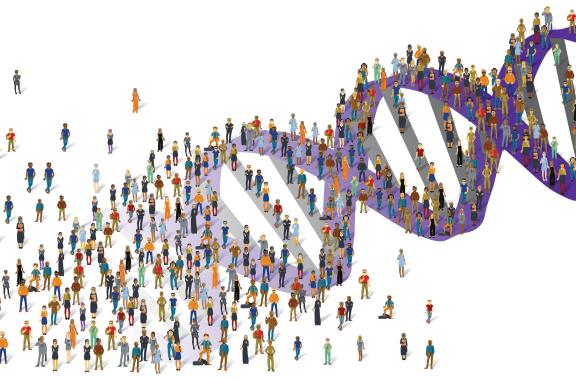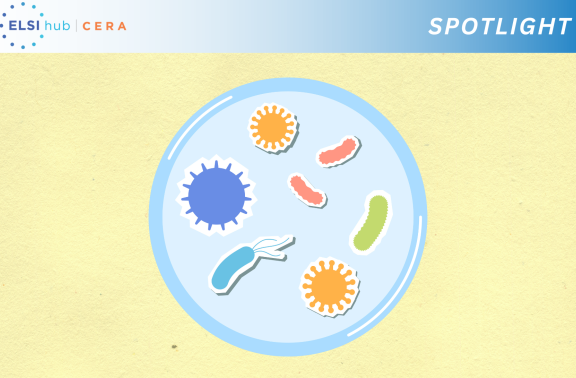
Using a Family Advisory Council to Understand the Informational Needs of Prospective Gene Therapy Trial Participants: An Interview with the Co-PIs of the SCDGENE CERA Working Group
Sickle cell disease (SCD), characterized by severe pain crisis and progressive organ damage as well as early death, is one of the most common inherited blood disorders in the world. However, since 90% of U.S. patients self-identify as Black and experience neglect as a result of structural racism, until recently, the condition has received very little research funding and minimal attention from the medical research community. Recent advances in human genetics have reinvigorated interest in the genetic underpinnings of SCD and the potential to “cure” it with novel genetic therapies. Several approaches, including gene replacement, gene suppression, CRISPR-Cas9 gene editing, and gene correction are in clinical trials or preclinical studies. Although the FDA will ensure that clinical trials for these new therapies will enroll adult patients first, it would be optimal to treat children and young adults with SCD before they develop irreversible organ damage that can occur later in the disease course. Given the racial and socioeconomic vulnerability of this potential stakeholder group, and the likelihood that these genetic therapies would be approved and commercially available before long-term safety data are available, researchers face the challenge of adequately informing prospective trial participants and their caregivers about both known and unknown potential harms.
This challenge is more formidable because we lack clear information about the adverse effects and possible long-term outcomes of many novel gene therapies. In addition, communication between patients and clinician researchers is obstructed by historical mistreatment and abuse of Black patients by the medical research establishment which have engendered mistrust among members of the SCD community. Individuals with SCD routinely experience disenfranchisement in their interactions with the healthcare system, explains SCDGENE Advisory Council facilitator, Yvonne Carroll, in a recent paper, for example, they wait longer to see an emergency room physician or receive pain medication. Black patients receive suboptimal care as evidenced by shorter visits, less information sharing from providers, and less shared decision-making. In addition, they experience subtle, nonverbal racial discrimination in the healthcare setting.
A paper by Craig Stewart and SCDGENE member, Amanda Young, characterizes the SCD community as “simultaneously harboring a deep-seated mistrust of medical research and a desperation for a cure for SCD.” Their analysis of a 60 Minutes report that announced the development of a gene therapy for SCD that employed a deactivated HIV vector without effectively explaining how HIV can be safely used for gene therapy, and the community reaction, highlights the understandable fear, skepticism, and misunderstanding that can occur when scientists and journalists are insensitive to the informational needs of the SCD community. This example clearly illustrates that understanding community needs and developing educational content that is both culturally sensitive and clinically sufficient are critical to address the communication challenges associated with participation in novel gene therapy trials.
CERA Working Group Co-Principal Investigators, Liza-Marie Johnson and Akshay Sharma partnered with SCD community members to accomplish their two-year project, The Novel Gene Therapies for Pediatric and Young Adults with Sickle Cell Disease: Engaging Patient and Parent Stakeholders (SCDGENE). Liza-Marie Johnson, MD, MPH, MSB, is an Associate Member and Program Director in the Department of Oncology in the Division of Hospitalist Medicine, and a Bioethics Consultant (Clinical & Research Consultations) at St. Jude Children’s Research Hospital. Akshay Sharma, MBBS, is an Assistant Member of the Department of Bone Marrow Transplantation and Cellular Therapy, also at the St. Jude Children’s Research Hospital. CERA Working Groups are interdisciplinary teams that aim to deepen our understanding of emerging, high priority, or understudied ELSI issues using innovative approaches. During their project, Drs. Johnson and Sharma oversaw the recruitment of the SCDGENE Family Advisory Council, a group comprised of individuals with SCD and parents of children with the disease from Seattle, Baltimore, and Memphis, and convened seven online discussions and one in-person meeting to discuss the educational and informed consent needs of patients and families who may one day be offered gene therapy. We asked them to reflect on the importance of their work and share broader lessons from their CERA Working Group experience.
CERA: Please paint a picture for our readers to help them understand the urgent need for novel SCD treatments.
Drs. Johnson & Sharma: Despite being one of the first genetic diseases with a molecular basis that was fully understood and described as early as the 1950s, until 2017, hydroxyurea was the only FDA approved drug for SCD. There are now four medications available to affected patients that help reduce the symptoms and prolong life, but they are not available to everyone, need to be taken regularly and on a lifelong schedule, and may have undesirable side effects. Also, despite these treatments, most individuals with SCD experience an average of 2 to 3 hospital admissions each year, lasting 5 to 6 days each. This not only puts a huge financial burden on them but also reduces their social, educational, and financial productivity.
CERA: Why are the voices of SCD stakeholders so important in the conversation about novel gene therapies?
Drs. Johnson & Sharma: As clinicians and researchers, we have our own implicit and explicit biases. Patient reported outcomes data (PROs) are increasingly being incorporated into clinical trials because patients and their caregivers have unique perspectives informed by their lived experience with the disease. It is important not to simply collect PRO data from patients after they are enrolled in a trial, but to involve them as stakeholders throughout the process, to foster true collaboration. As one example, members of the SCDGENE Family Advisory Council looked at existing content about gene therapy and observed that the loss of hair was never addressed. Temporary hair loss is a side effect of the conditioning chemotherapy medications, but this was not something that the content creators had identified as an important concern of potential trial participants. This is something that we learned by involving patient stakeholders.
CERA: You attended the first two meetings of the SCDGENE Family Advisory Council before handing over the meeting facilitator role to Yvonne Carroll, a nurse, lawyer, and patient advocate with over 20 years of experience working with the SCD community. How would you describe the role of the Council facilitator to others who may be considering a community engaged research strategy?
Drs. Johnson & Sharma: The facilitator is critical in engaging the participants and leading the discussions. The discussion is richer because of the breadth of experience of its participants, but its success is intertwined with the leadership of the facilitator. We found that a facilitator who is considered a member of the community by those in the group is essential to foster a bond characterized by trust and empathy, which is necessary to the success of the group because it enables an environment conducive to sharing ideas.
CERA: What other advice do you have for researchers who may be considering a similar approach?
Drs. Johnson & Sharma: We would suggest approaching patient stakeholders as true partners and emphasize that building and maintaining trust with them is essential for success. Try to level the playing field as much as possible because hierarchy can hamper communication.
CERA: Preliminary findings from your first set of SCDGENE Family Advisory Council meetings were presented at the Annual Meeting of the American Society of Hematology in December of last year. Could you please share some of those findings?
Drs. Johnson & Sharma: Advisory Council members agreed that communication about gene therapy by clinicians is suboptimal. They noted the use of medical jargon, approaches that are not tailored to the individual patient or their caregiver, and the lack of details that they would consider to be important, especially information about side effects like hair loss, risk of infertility, and risks associated with conditioning chemotherapy and immunosuppression. Parents of children with SCD expressed concern about unknown risks that might occur in the future and described the enormity of the decision to enroll their child in an early-phase trial. The Council also expressed the need to include patients with SCD as partners during the informed consent/assent process and ideally, at the outset of the clinical trial design. The full abstract with additional results can be found online.
CERA: What would an optimized trial consent process look like for these stakeholders?
Drs. Johnson & Sharma: Our work with the Family Advisory Council taught us that prospective trial participants prefer that a patient stakeholder be involved in the trial design and for sponsors to use a community based participatory research approach. They would prefer that an advocate participate in the informed consent process, ideally this would be an individual who has SCD or caregiver who has been through (or is familiar with) the intervention being offered. Our work with the Advisory Council and our previous research with patient stakeholders, leads us to recommend a multi-modal communication approach using audiovisual components that both support different learning styles and are accessible to individuals who may have low literacy. Individuals offering a clinical trial should avoid the use of medical jargon, allow time for participants to ask questions, and try to assess for understanding. Often, asking a patient to summarize what they understand can help the consenter understand what, if any, gaps in understanding exist. We recommend allowing sufficient time and at least a two-visit informed consent process for novel or complex clinical trials.
Drs. Johnson and Sharma have begun to use the insights they gathered from the SCDGENE Family Advisory Council to inform the production of video and web-based educational content for individuals who are considering enrollment in novel gene therapy clinical trials. They are also continuing this work as members of a new CERA Working Group, Value Ethics: Mapping Strategies for Value Assessment and Reimbursement of Gene Therapies for Rare Diseases.
If you would like to learn more about this topic, you can watch the recorded webinar, “Ethical Challenges in Novel Gene Therapies for Sickle Cell Disease,” featuring Dr. Johnson and others, or explore The Many Faces of Sickle Cell Disease and After 10 Years of Testing All College Athletes for Sickle Cell Trait, What Have We Learned?, short lessons about SCD for high school and college students, created by the Personal Genetics Education Project (pgEd). You can also find interview guides, educational materials, decision aids and more created by ELSI researchers in the Research Tools database on ELSIhub.


